This page has been formatted to facilitate printout of the review.
Use your browser's "Back" button to return to the previous page, or the links at the top and bottom of this page to navigate to related information. If you have difficulty fitting the text on this page onto your printer output, simply resize your browser window to a narrower width and print again.
Remember us when it's time to buy!
Dave here: Have our reviews been helpful to you? (Is this article you're reading right now useful?) Preparing this level of information on as many products as we do is incredibly hard work, not to mention expensive. Things on the Internet may look like they're free, but they're not. (As a lot of big dot.com companies are finding out these days.) Somewhere, somebody has to pay to produce worthwhile content. YOU can help us though, by remembering us when it comes time to make your purchase. Would you consider coming back to our site and clicking-through to one of our advertisers to make your purchase? Every dollar you spend with one of our advertisers helps us directly (in affiliate fees) or indirectly (the advertiser will keep renewing their ad contract with us). To make it easy for you to support us, here's a URL you can visit, to see all our current advertisers, with links to click on that will register your visit to them as having come from our site. It's up to you where you buy, but Mike, Mike, Kim, Yazmin, Marti and I would be really grateful if you'd help us out by choosing one of our advertisers to purchase from.
Thank you for your support!
Dave Etchells, Founder & Publisher
Visit our "Buy Now" Page:
https://www.imaging-resource.com/buynow.htm
 Back
to Full Canon PowerShot S10 Review
Back
to Full Canon PowerShot S10 Review
Go to Canon PowerShot S10
Data Sheet
Go to Canon PowerShot S10
Pictures Page
Up to Imaging Resource Cameras
Page
Canon PowerShot S10
Canon packs 2 megapixels and a 2x optical zoom into the smallest digicam yet!
Review First Posted: 12/5/1999
|
|
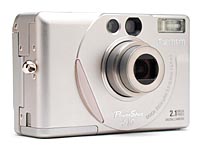 |
*
|
True 2 megapixel sensor for 1600x1200 images |
|
*
|
2x optical zoom lens |
|
*
|
Tiny body, smallest currently on the market! |
|
*
|
Exceptional image quality |
|
*
|
Rugged all-metal construction, auto lens cover |

Manufacturer Overview
Canon has long been a leader in the film-based photography world, and has developed a popular line of digital cameras as well. In recent history, their PowerShot Pro70 introduced exceptional image quality and many "studio-friendly" features at the 1.7 megapixel level in late 1998. Recently, they've made waves with a series of digicams in exceptionally compact metal bodies, echoing the style of their wildly popular "ELPH" film cameras. The latest addition to this line is the PowerShot S10, a full 2 megapixel camera with a 2x optical zoom lens, packed into what's arguably the smallest body in the digicam market. We predict that this compact form factor, combined with its exceptional image quality, will make it one of the more popular digicam designs currently on the market.

Highlights
- 2.1 megapixel, 0.5 inch CCD sensor

- 1.8 inch, low temperature, polycrystalline silicon, TFT LCD

- 1600 x 1200, 1280 x 960 and 800 x 600 pixel sizes

- 6.3 to 12.6mm, F/2.8 to F/4.0, 2x zoom lens (equivalent to a 35 to 70mm
lens on a 35mm camera)

- Mechanical and electronic shutter from two to 1/1,000 seconds

- Built-in flash with Auto, On, Off and Red-Eye Reduction modes

- White balance with Auto, Daylight, Cloudy, Tungsten and Fluorescent settings

- Digital zoom up to 4x

- ISO settings from 100 to 400

- Stitch Assist mode for creating multi-frame panorama shots

- Image mode with preset settings for specific circumstances (landscape, night
scenes, black & white, etc.)

- CompactFlash media for image storage (type I or II)

- USB interface

- NTSC or PAL video out

- DPOF (Digital Print Order Format) compatibility settings
Executive Overview
We've always been big fans of compact cameras, subscribing to the theory that
a camera that sits in a drawer doesn't take many pictures. Accordingly, we were
definitely excited about the exceptional compactness of the PowerShot S10. It's
actually the smallest digital camera currently (October, 1999) on the market although
the rectangular body shape makes it look a little bigger than some others noted
for their 'pocketability.' The all metal body and metal tripod socket add greatly
to the sense of ruggedness and sturdy durability that we find with the S10. We
really liked the design of the battery compartment, which automatically locks
into place when you close it. A built-in automatic shutter protects the lens,
making you feel a little more confident about just dropping it in your pocket
on the way out the door. But don't let its small size fool you, its resolution
reigns at the top of the current two megapixel category, with excellent image
quality to boot.

The optical viewfinder doesn't feature a dioptric adjustment, but it does have
a high eye point which should make eyeglass wearers a little more comfortable.
Overall, we found the optical viewfinder quite "loose", although the
accuracy is very consistent from wide angle to telephoto on the zoom lens. Alternatively,
the LCD monitor shows a bit more of the subject on the wide angle end than the
final image reveals while the telephoto end showed about 95 percent accuracy.
A bonus is the optional live status display on the LCD monitor, which displays
small menus down the sides of the monitor.

We found the 6.3 to 12.6mm, F/2.8 to F/4.0, 2x zoom lens (equivalent to a 35 to
70mm lens on a 35mm camera) a little limited, compared to the abundance of 3x
zooms out on the market. But the resolution places the S10 at the top of the current
(October 1999) two megapixel marketplace with about 700 lines per picture height,
in both vertical and horizontal directions. Zoom action is fairly smooth, although
it's not as sensitive to the controls as we might like it to be. We did appreciate
the bright autofocus assist light which aids focusing in dim lighting situations
(but it's a two-edged sword as it takes a big bite out of battery power).

We experienced good exposure control and enjoyed the option of four shooting modes
(Automatic, Manual, Stitch Assist and "Image"). Automatic mode is pretty
straightforward with the camera making all the decisions while Manual gives you
control over exposure compensation (EV) and white balance. Image capture mode
was helpful for fast shooting situations, providing preset exposure settings for
landscapes, night scenes, etc. The Stitch Assist mode takes the guesswork out
of panorama shots.

The Gain setting provides versatile ISO (light sensitivity) adjustment options
from zero (100 ISO), to +1 (ISO 200) and +2 (ISO 400). Although you don't have
any direct control over shutter speed or aperture settings, the S10's automatic
shutter covers a wide range from two to 1/1,000 seconds. The built-in flash operates
in four modes: Auto, Red-Eye Reduction, On and Off and features through the lens
metering which increases the accuracy.

Feature-wise, the S10 offers a very versatile selection. The digital telephoto
function magnifies up to 4x and can be turned off and on through the record settings
menu. Additionally, the macro function allows you to capture subjects from 4.7
to 18 inches (12 to 46 cm) away and is accessible in all four capture modes. The
Self-Timer gives you 10 seconds once the shutter button has been pressed, indicated
by the self-timer light on the front of the camera. In the continuous shooting
mode, the S10 captures approximately 1.7 images per second, depending on the amount
of space on the CompactFlash card, the entire time the shutter is held down.

Exposure compensation is adjustable from -2 to +2EV in Manual, Image and Stitch
Assist modes. Likewise, white balance offers Auto, Daylight, Cloudy, Tungsten
and Fluorescent settings but is only available in Manual, Image and Stitch Assist
capture modes. In Manual capture mode only, you can choose between spot and center
weighted metering, depending on the composition of your subject. You can also
adjust contrast and sharpness, giving you further control over the final image.

The S10 utilizes CompactFlash for image storage and comes with an 8MB card, which
of course is upgradeable. Images can be stored as Superfine, Fine or Normal quality
(compression level) and at resolutions of 1600 x 1200, 1280 x 960 and 800 x 600.
When it comes to power, the S10 uses either a rechargeable, nickel-hydride NB-5H
battery pack or a 2CR5 lithium battery, with a CR2016 lithium battery backing
up the internal calendar. The PowerShot S10 is sold in the US without the optional
NiMH battery pack, charger, and AC adapter cable. In our view, these items really
should be included with the camera, as it would be prohibitively expensive to
operate the camera on 2CR5 lithium cells all the time. Thus, when comparing digicam
prices, be sure you include the cost of the battery/charger kit with that quoted
for the S10 itself.

Two software CDs and serial cables for Mac and PC come with the camera (we were
thrilled by the inclusion of a USB cable). The PowerShot Browser program downloads
the images from the camera, PhotoStitch pieces together panorama shots and Adobe
PhotoDeluxe gives you image manipulation and correction capabilities. There's
also an NTSC video cable for connection to a television set, which can be used
for image playback or composition.

Other than a few minor drawbacks here and there (the limitation of a 2x zoom lens,
etc.), we really liked the S10. The most impressive feature is its compact size
and carefree portability, which is definitely a plus in the current digicam marketplace.
But beyond that, the four capture modes and variety of exposure control options
ensure high quality images that give you more than the usual amount of control
over the composition. Best of all, the picture quality is second to none.

Camera Design
What a slim, compact camera! The PowerShot S10 is actually the smallest camera
currently on the market, as of October 1999. Although its rectangular shape makes
it look a little bigger, the S10 is very pocket friendly at 4.1 x 2.7 x 1.3 inches
(105.4 x 69.4 x 33.8 mm). Weighing in at approximately 9.5 oz. (270g) without
the battery and CompactFlash card, the S10's all metal body makes it a little
bit heavier but a good bit sturdier as well.

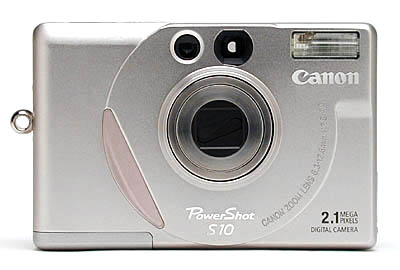

The very sleek front of the camera features the lens, flash, preflash (red-eye reduction/focus-assist) light and optical viewfinder, all very smooth with no protrusions when the camera is off (except the slight lip of the front grip). When the camera is turned to a capture mode, the protective shutter over the lens opens and the lens pops out from its compartment but still maintains a low profile.

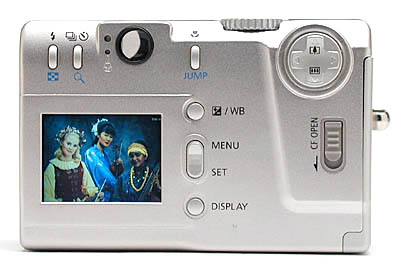

Around back, the majority of the control buttons, CompactFlash slot trigger, optical viewfinder and LCD panel take up most of the space. Consistent with the styling of the front of the camera, the back has no major protrusions.

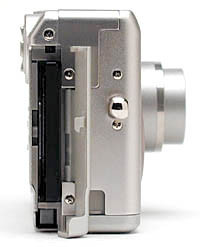

The media side (right side, viewed from the rear) of the S10 holds the CompactFlash slot, wrist strap attachment and DC coupler cable cover (a little slot to accommodate the cord of the AC adapter). The positioning of the CompactFlash card and the slot cover make it a little finicky to get the card out of the slot. It would have been much easier if the card were turned to face the other direction, exposing the little lip most CompactFlash cards have on the back side, which is perfect for hooking with a fingernail.

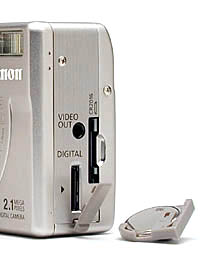

The opposite side of the S10 features the video and digital jacks as well as a slot for the CR2016 battery (the CR2016 powers the S10's internal clock/calendar). The video jack remains exposed while the digital I/O port has a soft rubber cover that snaps into place to protect the interface.

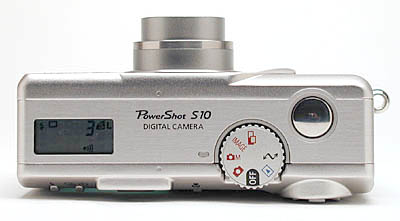

A small status display, the mode dial and the shutter button live on top of the S10, all maintaining a very low profile.

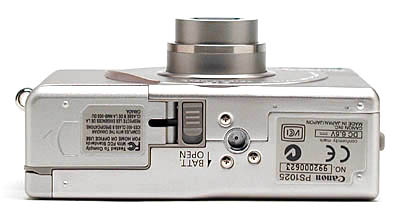

Finally, the very flat bottom of the camera features a metal tripod mount and
battery compartment. A big plus here, relative to some of the earlier Canon
digicams, is that the battery cover now locks automatically. In previous designs,
if you didn't slide the lock button shut after inserting a battery, the camera
would be dead. This caused us some slight consternation the first time we used
both the original A5 and the subsequent A50.

Viewfinder
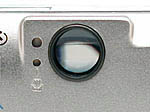 Although
the S10's optical viewfinder doesn't feature a dioptric adjustment, it has a relatively
high eye point, making it comfortable for eyeglass wearers. We found the optical
viewfinder to be rather "loose", showing only 77 percent of the final
image area, and what it does show is biased slightly toward the top of the field
of view. The good point about it though, is that the accuracy doesn't vary at
all from the wide angle to the telephoto end on the zoom lens, meaning that you
don't have to mentally compensate for varying accuracy as you zoom the lens. Still,
we'd really like to see it a bit tighter. The optical viewfinder does feature
center autofocus target brackets, helpful when composing.
Although
the S10's optical viewfinder doesn't feature a dioptric adjustment, it has a relatively
high eye point, making it comfortable for eyeglass wearers. We found the optical
viewfinder to be rather "loose", showing only 77 percent of the final
image area, and what it does show is biased slightly toward the top of the field
of view. The good point about it though, is that the accuracy doesn't vary at
all from the wide angle to the telephoto end on the zoom lens, meaning that you
don't have to mentally compensate for varying accuracy as you zoom the lens. Still,
we'd really like to see it a bit tighter. The optical viewfinder does feature
center autofocus target brackets, helpful when composing.

Alternatively, the LCD monitor goes toward the other extreme, actually showing
a bit more of the subject than what appears in the final image, at least at the
wide angle end of the range (101.8 percent of final field of view shown). At the
telephoto end, we found about 95 percent accuracy. This variation in accuracy
figures for wide angle and telephoto is possibly due to the difficulty we experienced
in seeing the extreme edges of the image in the LCD when conducting our tests.
Overall though, the S10's LCD viewfinder is more accurate than most. A handy feature
on the LCD monitor is the live status display option (the little menus down the
sides of the LCD viewfinder, if you have the display mode set right), easily disabled
when you want an unobstructed view.

In playback mode, the playback zoom works very nicely, with smooth scrolling around
the image and a little position indicator in the lower right hand corner so you
don't get lost. (This is one of the better implementations of playback zoom we've
seen to date.)
 Optics
Optics
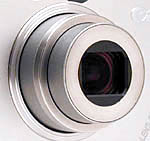 The
S10's 6.3 to 12.6mm, F/2.8 to F/4.0, 2x zoom lens (equivalent to a 35 to 70mm
lens on a 35mm camera) seems a little limited, with most competing models providing
a 3x ratio. But the lens is of good quality, as evidenced by the resolution, which
is at the top of the current (October 1999) two megapixel marketplace with about
700 lines per picture height, in both vertical and horizontal directions. Focus
ranges from 18 inches (46cm) to infinity and the zoom action is fairly smooth,
although it's not as sensitive as we'd like it to be.
The
S10's 6.3 to 12.6mm, F/2.8 to F/4.0, 2x zoom lens (equivalent to a 35 to 70mm
lens on a 35mm camera) seems a little limited, with most competing models providing
a 3x ratio. But the lens is of good quality, as evidenced by the resolution, which
is at the top of the current (October 1999) two megapixel marketplace with about
700 lines per picture height, in both vertical and horizontal directions. Focus
ranges from 18 inches (46cm) to infinity and the zoom action is fairly smooth,
although it's not as sensitive as we'd like it to be.

Optical distortion on the S10 is fairly low, with the lens showing 0.5 percent
barrel distortion at wide angle and 0.3 percent (almost undetectable) at the telephoto
setting. Chromatic aberration is almost non-existent, estimated at less than half
a pixel at all focal length settings. (This distortion is visible as a very slight
colored fringe around objects at the edges of the field of view on the resolution
target).

The S10 has a bright autofocus assist light that comes on in dim lighting situations.
This really helps when focusing in dark conditions, but it will also give you
away if you're trying for candids. Unfortunately, the assist light also takes
a big gulp of the battery power, albeit for a very short time. (We really don't
dislike the AF light though, since focusing is a digicam bugaboo and we'd like
to see more digicams with this feature.)
 Exposure
Exposure
We experienced fairly good exposure control on the S10, and liked the variety
of capture options available. Automatic remains relatively straightforward while
Manual gives you control over both exposure compensation (EV) and white balance.
We found the Image capture mode helpful for many shooting situations, since it
provides preset exposure settings for landscapes, night scenes, etc., although
we were a bit puzzled by the exact function of some of them. Some were obvious,
such as "slow shutter", which sets the autoexposure system to choose
smaller apertures and longer shutter speeds. Likewise, "fast shutter"
does the opposite, preferring larger apertures and higher shutter speeds. Night
Shot mode apparently pairs longer exposure times with use of the onboard strobe,
to produce flash exposures with better-lit backgrounds. We really aren't sure
what "Landscape" mode does though, unless it involves some of the other
image adjustments the camera is capable of, such as sharpening or contrast adjustment.
Another plus is the Stitch Assist mode, which helps you compose panoramic shots
(said shots to be subsequently merged with the included PhotoStitch software).

ISO is adjustable under the Gain option in the record menu, with options of zero
(ISO 100), +1 (ISO 200) and +2 (ISO 400). Although you don't have any control
over shutter speed or aperture settings, the S10 offers shutter speeds from two
to 1/1,000 seconds and aperture ranges from F/2.8 to F/8.0. These specifications
should translate into a usable lighting range of EV 4 to EV 21, using our previous
terminology, or 0.13 to 16,000 foot-candles (1.4 to 175,000 lux) In actual tests,
we found the camera somewhat less sensitive than this, producing usable images
down to light levels of 1 foot-candle (11 lux). This should be adequate for nighttime
photography under bright streetlights or indoors at malls, etc. Strangely enough,
the +1 and +2 ISO settings didn't extend the low light capability to lower illumination
levels. These settings appear to only be useful for permitting higher shutter
speeds in otherwise adequately lit environments.

Flash
The S10's flash offers four modes of operation (Auto, Red-Eye Reduction, On and
Off) and ranges from 6.7 inches to 10.8 feet (17cm to 3.3m) in wide angle and
6.7 inches to 7.5 feet (17cm to 2.3m) in telephoto. Auto lets the camera do all
the work and is available in all shooting modes except Stitch Assist. Red-Eye
Reduction emits the standard pre-flash before firing the full flash and is only
available in Manual and Image capture modes. The On setting means that the flash
always fires, available in all modes except for Automatic capture. The Off setting
means that the flash never fires. All flash modes are accessed by pressing the
Flash button on the back of the camera until the appropriate icon appears on the
status display. An excellent feature is that the flash metering is actually performed
through the lens, not via a separate sensor on the front of the camera. It's therefore
more likely to be accurate, particularly as the lens zooms from wide angle to
telephoto.


Digital Telephoto
We found the continuous digital telephoto operation interesting-Through some trickiness
with the optical zoom lens, it zooms smoothly through the full zoom range. It's
also relatively simple to access. Once the lens is at the maximum optical telephoto
setting, keep pressing the up arrow to continue into the digital zoom. The digital
zoom will engage, and the lens will rack back to the wide angle setting. The net
result is that you're about where you were in terms of effective focal length,
but now with the optical zoom at the wide angle end of its range. As you continue
to zoom in, the optical zoom does the work, eventually ending up at its 2x setting,
producing a total zoom ratio of 4x. If you continue to hold down the telephoto
zoom control, the entire process will repeat again, this time with the digital
zoom engaged at a 4x magnification ratio. Press on the bottom of the rocker toggle
(wide-angle zoom button) to pull back out. Zoom status is displayed in an optional
overlay (it can be switched off), in the form of a vertical "zoom bar"
on the right hand side of the LCD monitor. (In the photo above right, the zoom
is midway through the 2x digital zoom range.) You can disable the digital zoom
by hitting the Menu button in Automatic, Manual and Image capture modes. Once
in the record menu, select the Digital Zoom option and select either On or Off.
It's also important to note that the digital zoom is only available when the LCD
monitor is in use.

Keep in mind that "digital zoom" is very different from the zoom effect
provided by the optical zoom lens: So-called digital zoom only increases the apparent
magnification by cropping into the image, essentially throwing away information
from the periphery of the CCD. Thus, as the digital zoom ratio increases, the
resolution decreases in direct proportion. With a 2 megapixel digicam like the
S10, digital zoom is actually fairly useful when shooting at lower resolution
settings, since you don't need the full sensor resolution then anyway. (The S10
interpolates the digital tele images back up to whatever pixel size you have the
camera set to: At smaller sizes, less interpolation is involved, producing a smaller
but sharper image.)

Self-Timer
In all four capture modes, the Self-Timer is accessed by pressing the Self-Timer/Continuous
button on the back of the camera (just beside the Flash button). After the shutter
button is fully pressed, the self-timer indicator will flash slowly on the front
of the camera for the first eight seconds and then accelerate for the remaining
two ( a total of 10 seconds). To cancel the mode, just hit the Self-Timer button
again or turn the camera off. Since the self-timer is activated by its own control
button, you can use it in conjunction with macro mode, a very desirable feature
for avoiding camera shake when you're using a tripod.

Macro
The S10's Macro function allows you to capture images from 4.7 to 18 inches (12
to 46 cm) away. Macro is accessible in all four capture modes by pressing the
Macro button, indicated by the traditional flower symbol. A tiny LED next to the
optical viewfinder lights orange when the shutter button is halfway pressed in
Macro mode. The mode is just as easily canceled by hitting the Macro button a
second time.

Continuous Mode
The S10 will shoot continuously at approximately 1.7 images per second, depending
on the amount of space on the CompactFlash card (the interval increases as the
space fills up). In this mode, the camera shoots continuously until the shutter
button is released. Access the function in either Manual or Image capture modes
by pressing the Self-Timer/Continuous button until the Continuous Shooting icon
appears on the status display. Cancel it the same way.

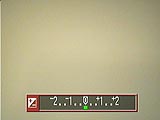
Exposure Compensation
When shooting in Manual, Image or Stitch Assist capture modes, the S10 gives you
some control over exposure compensation. The +/-/WB button pulls up the settings
bar, where you use the right and left arrow buttons to select an EV value from
-2 to +2. You can dismiss the menu by pressing the Set button and the shutter
button can be pressed at any time to capture an image. Note that the setting remains
the same, even if the mode dial is turned (the +/- icon will appear in the status
display with the EV value).


White Balance
The same +/-/WB button calls up the white balance settings bar, also adjustable
with the right and left arrow keys. Five white balance options are available:
Auto, Daylight, Cloudy, Tungsten and Fluorescent. The white balance option is
available in Manual, Image and Stitch Assist capture modes only. Like exposure
compensation, this setting remains in effect even after the mode dial is turned.
The WB symbol also appears in the status display.

Metering
You can choose between spot and center weighted metering on the S10 (in Manual
mode only) by pressing the Set button and using the right and left arrow buttons
to select the option. Center weighted metering takes an average reading of the
entire image, weighting the value of the light at the center of the viewfinder
more heavily. Spot metering measures the light from the very center of the field
only and is best for backlit subjects.

Gain, Contrast and Sharpness
We mentioned the Gain setting earlier, which controls ISO. In the record menu,
you have the option of zero (100 ISO), +1 (200 ISO) and +2 (400 ISO). The higher
ISO values are best for darker situations and fast shutter speeds, but produce
more image noise. In the same menu, you can also adjust the contrast and sharpness
settings. On both settings, '-' means low, zero is normal and '+' is high, all
adjustable via the right and left arrow buttons. A number of cameras offer sharpness
adjustments and several now provide ISO options, but the contrast adjustment is
fairly uncommon.
 Shutter Lag/Cycle Times
Shutter Lag/Cycle Times
When you press the shutter release on a camera, there's usually a delay before
the shutter actually fires. This time allows the autofocus and autoexposure mechanisms
time to do their work and can amount to a fairly long delay in some situations.
Since this number is almost never reported on, and can significantly affect the
picture taking experience, we now routinely measure it (using an electronic test
setup, with time resolution limited only by the camera's shutter speed.)

On the S10, we measured the shutter lag time with full auto focus at about 1.1
seconds, a little slower than most of the field. Alternatively, shutter lag with
prefocus (a half press of the shutter button before the actual exposure itself)
is only 0.19 seconds, slightly faster than most.

The camera obviously has some buffer memory, as the first three shots in high-res
mode are much faster than the subsequent ones. We found the shot-to-shot cycle
time at the maximum resolution and image quality setting to be about 3.7 seconds
for first three shots of a rapid fire series. The time then increased to 6.7 seconds
for all succeeding ones. It seems like the camera is continuously emptying out
the buffer memory as you prepare for the next shot. Consequently, if you wait
more than 15 or 20 seconds after the last shot, you'll be able to shoot another
three in rapid succession. In the lower resolution settings, the minimum shot-to-shot
cycle time is about the same, but you can shoot proportionately more frames before
you run out of buffer memory. A helpful feature is a little readout that shows
up in the status display, clueing you into how much buffer memory is available.

With an IBM MicroDrive (340 megabyte hard drive-based Type II CompactFlash storage
card), cycle time after the buffer is filled decreased to only 4.8 seconds, and
the buffer memory emptied much more quickly after the last shot was taken: Only
about 10 seconds to completely empty the buffer, as compared to 23 seconds with
standard CompactFlash cards.

Shot-to-shot cycle times in the Continuous Shooting mode are 0.63 seconds (1.59
frames per second) in the lowest quality mode and around 4.2 seconds in highest
quality setting.
 User Interface
User Interface
The S10 features a pretty user-friendly interface, although some of the menu navigation
was complex (arrow buttons navigate but you have to remember to hit the Set button
to select an option). All the controls are clearly labeled and relatively well
laid out, with the exception of the rocker toggle button, which we wish was a
little closer to the Menu and Set buttons. Let's look at each button individually:


Shutter Button
Located on the top right of the camera and silvery smooth, a half press sets the
exposure and focus while a full press fires the shutter.


LCD Data Readout
Located at top left of the camera, a small black & white data readout displays
a wide range of information about the camera's current modes and settings. You
still need to enter the main LCD menu system (using the rear-panel color LCD screen)
to make changes in most settings, but this readout at least saves you having to
use the menu system just to check status.


Mode Dial
Also located on the top right of the camera, the mode dial is silver and notched
for simple turning. This dial controls the operating mode of the camera with the
following choices:
 Stitch Assist: lets you take multi frame panoramic shots to be assembled on a computer. (Exposure and white balance are "locked" when the first picture of the series is taken, and remain the same until you exit from the Stitch Assist mode. The left arrow key lets you "back up" to reshoot the picture just took, and the "Set" button starts a new panorama sequence.)
Stitch Assist: lets you take multi frame panoramic shots to be assembled on a computer. (Exposure and white balance are "locked" when the first picture of the series is taken, and remain the same until you exit from the Stitch Assist mode. The left arrow key lets you "back up" to reshoot the picture just took, and the "Set" button starts a new panorama sequence.)

 Image: offers several preset exposure settings for various shooting conditions including:
Image: offers several preset exposure settings for various shooting conditions including:
- Landscape
- Fast Shutter
- Slow Shutter
- Night Scene
- Black & White

 Manual: gives you control over minor exposure settings like white balance and exposure compensation. Settings made in manual mode are saved, and remain in effect even when the camera is turned off and back on again.
Manual: gives you control over minor exposure settings like white balance and exposure compensation. Settings made in manual mode are saved, and remain in effect even when the camera is turned off and back on again.

 Automatic: puts the camera in control of all exposure settings.
Automatic: puts the camera in control of all exposure settings.

 Off: powers off the camera.
Off: powers off the camera.

 Playback: allows you to review captured images.
Playback: allows you to review captured images.

 PC: allows the camera to download images into a computer.
PC: allows the camera to download images into a computer.

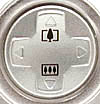
Rocker Toggle Button
Located on the top right hand side of the back panel of the camera, marked with arrows in four directions and telephoto and wide angle icons.
- In Playback and all capture modes, this button navigates settings menus.

- In all capture modes, activates the optical zoom function (up and down arrows).

- In Automatic, Manual and Image capture modes, accesses the digital zoom function (up and down arrows) once the end of the telephoto range is reached.

- In Playback mode, scrolls through recorded images.


Macro / Jump Button
Located in the top middle of the back panel, marked with a black flower symbol and the word 'jump' in blue.
- In all capture modes, activates and deactivates the Macro function.

- In Playback mode, turns on the jump function which allows you to jump from the first to the tenth image and so on.


Continuous / Self-Timer / Magnification Button
Located to the left of the optical viewfinder on the back panel, marked with black continuous shooting and self-timer symbols as well as a blue magnifying glass.
- In all capture modes, cycles through the Self-Timer and Continuous Shooting modes.

- In Playback mode, allows you to digitally zoom into a recorded image.


Flash / Multi Button
Located to the left of the Continuous / Self-Timer / Magnification Button and marked with a black flash symbol and blue multi symbol.
- In all capture modes, cycles through the flash modes.

- In Playback mode, cycles between one and nine images on the screen.


+/- / WB Button
Located beneath the Macro/Jump button, to the right of the LCD monitor and marked with a black +/- and 'WB.'
- In Manual, Image and Stitch Assist, cycles between the exposure compensation (EV) settings bar and the white balance settings bar.


Menu Rocker Button
Located beneath the +/- / WB button, marked with the word 'menu' in black.
- In Playback and all four capture modes, accesses and dismisses the settings menus.


Set Rocker Button
Located on the bottom of the Menu button and marked with the word 'set' in black.
- In all settings menus, confirms menu selections.


Display
Located beneath the Menu/Set Rocker Button and marked with the word 'display' in black.
- In all capture modes, controls the LCD monitor. One press turns off the information display, a second turns off the image and a third recalls both.

- In Playback mode, shows the exposure information about the selected image.


CF Open Slide Switch
Located beneath the rocker toggle button, opens the CompactFlash slot.

Camera Modes and Menus


Stitch Assist Mode
Accessed by turning the mode dial to the red stitch assist symbol. This mode allows
you to take multi frame shots for panorama images (assembled later with the PhotoStitch
software). Pressing the Menu button in this mode pulls up the following options
under the Record Menu:

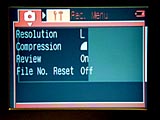
- Resolution: selects between L (1600 x 1200), M (1280 x 960) and S (800 x 600).

- Compression: selects between Super Fine, Fine and Normal.

- Review: turns image review on and off.

- File Number Reset: turns the file number reset function on and off. (When off, the numbers in file names increment continually, preventing accidental overwriting of previous files when you transfer images to your hard drive.)

While in the Record Menu, scrolling to the top of the LCD menu screen and over one accesses the Camera Setup Menu with these options:

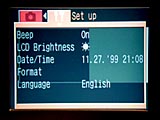
- Beep: turns the camera beep sound on and off.

- LCD Brightness: adjusts the brightness of the LCD display.

- Date/Time: sets the camera date and time.

- Language: selects between English, German, French, Spanish and Japanese.


Image Mode
Accessed by turning the mode dial to the word 'image' in red letters, this mode allows you to select from preset exposure settings. The menu at the bottom of the screen offers the following options:

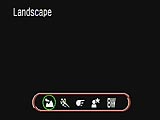
- Landscape: (Unknown operation(?)) for recording broad expanses of scenery.

- Fast Shutter: Favors wider lens apertures and faster shutter speeds, for fast moving objects like sports, etc.

- Slow Shutter: Favors smaller lens apertures and slower shutter speeds, for recording moving objects to achieve a blurred effect, like white water rapids.

- Night Scene: Combines longer shutter times with flash exposure, to provide for brighter backgrounds with night subjects.

- Black & White: Records monochrome images.

Pressing the Menu button in this mode gives the following options under the Record Menu:

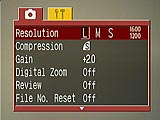
- Resolution: selects between L (1600 x 1200), M (1280 x 960) and S (800 x 600).

- Compression: selects between Super Fine, Fine and Normal.

- Digital Zoom: turns the digital telephoto function on and off.

- Review: turns image review on and off.

- File Number Reset: turns the file numbering reset on and off.

While in the Record Menu, scrolling up to the top of the screen and over to the right one pulls up the Camera Setup Menu:

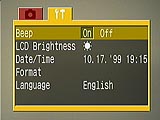
- Beep: turns the camera beep sound on and off.

- LCD Brightness: adjusts the brightness of the LCD display.

- Date/Time: sets the camera date and time.

- Format: formats the CompactFlash card.

- Language: selects between English, German, French, Spanish and Japanese.


Manual Mode
Accessed by turning the mode dial to the red camera symbol denoted with an 'm.' Manual gives you some control over exposure compensation (EV) and white balance in addition to a few other settings. Pressing the Menu button in this mode pulls up the Record and Camera Setup Menus:

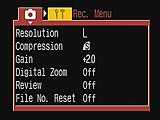
- Resolution: selects between L (1600 x 1200), M (1280 x 960) and S (800 x 600).

- Compression: selects between Super Fine, Fine and Normal.

- Gain: selects between zero (ISO 100), +1 (ISO 200) and +2 (ISO 400).

- Digital Zoom: turns the digital telephoto function on and off.

- Review: turns the image review function on and off.

- File Number Reset: turns the file number reset function on and off.

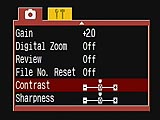
- Contrast: sets the image contrast.

- Sharpness: sets the image sharpness.

Scrolling up and over to the Camera Setup Menu gives the same options as described earlier under the "Image" setup options.


Automatic Mode
Accessed by turning the mode dial to the lone red camera symbol. This setting gives the camera complete control over exposure. Pressing the Menu button in this mode pulls up the Record and Camera Setup Menus with these options:

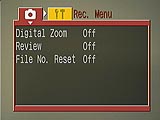
- Digital Zoom: turns the digital telephoto function on and off.

- Review: turns the image review function on and off.

- File Number Reset: turns the file number reset function on and off.

Scrolling up and over to the Camera Setup Menu gives the same options as described earlier under the "Image" setup options..


Playback Mode
Accessed by turning the mode dial to the blue playback symbol. This mode allows you to review, write protect and erase images. Pressing the Menu button brings up the Play and Camera Settings menus with these options:

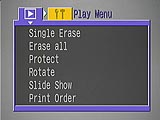
- Single Erase: erases a selected image.

- Erase All: erases all images on the card.

- Protect: write protects individual images.

- Rotate: rotates a selected image 90, 270 and zero degrees clockwise.

- Slide Show: activates the slide show playback of all images.

- Print Order: selects individual images for printing (DPOF compliant).

Scrolling up and over to the Camera Setting Menu gives the same options as
described earlier under the "Image" setup options.


PC Mode
Accessed by turning the mode dial to the black data transfer symbol, this mode
allows you to connect the camera to your computer and download images.

Image Storage and Interface
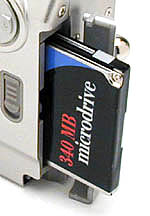 The
S10 utilizes CompactFlash as its image storage medium, which should never be removed
from the camera while in use. An 8MB card comes with the camera, but Canon-branded
cards are available to 15MB, 30MB and 48MB.
The
S10 utilizes CompactFlash as its image storage medium, which should never be removed
from the camera while in use. An 8MB card comes with the camera, but Canon-branded
cards are available to 15MB, 30MB and 48MB.

The S10 is one of the few digital cameras currently (November, 1999) on the market
that accepts "Type II" CompactFlash cards. These thicker cards allow
for higher storage capacities, and even rotating-media storage like the incredible
IBM MicroDrive. - The MicroDrive provides 340 or 170 megabytes (two models) of
storage in the just slightly-thicker-than-normal Type II CompactFlash package.
With digicams like the S10 making ever-larger files, the availability of truly
large-capacity storage devices for them is becoming increasingly important. In
the case of the S10, it's highest-quality images occupy about 2 megabytes. With
the standard 8 MB CompactFlash card included, you can only store 4 maximum-quality
images per card. With a 340 megabyte MicroDrive, the count goes up to 236! - Enough
to keep even the most rabid shooter busy for the day! We heartily applaud Canon
for supporting the Type II standard, and encourage other manufacturers to do so
as well.

The S10 organizes images into storage folders, assigned numbers from 100 to 998.
Within each folder, images are numbered from 0001 to 9900, with each folder containing
up to 100 files. Note that images shot in Stitch Assist mode are always kept in
the same folders, possibly resulting in some folders having 101 or more files.

You can protect individual images on the CompactFlash card through the Play menu
(in Playback mode). This prevents accidental erasure of images. If you want to
erase images, the Play Menu offers both Single Erase and Erase All options. The
standard 8MB card provided with the S10 holds between 4 and 61 images, depending
on the combination of image resolution and quality selected.

| Resolution/Quality vs Image Capacity |
High Resolution
|
Standard Resolution
|
Low Resolution
|
|
Images
|
Approx.
Compression
|
Images
|
Approx.
Compression
|
Images
|
Approx.
Compression
|
| Super Fine Quality |
4
|
3:1
|
7
|
3:1
|
15
|
3:1
|
| Fine Quality |
12
|
8:1
|
18
|
8:1
|
33
|
6:1
|
| Normal Quality |
24
|
17:1
|
33
|
15:1
|
61
|
11:1
|
Video Out
An NTSC video cable comes packaged with the S10, allowing you to connect the
camera to your television set for image playback or use as a viewfinder. All
modes except Stitch Assist are available and the LCD monitor remains blank while
connected to a TV. We assume that European models come with the appropriate
cables for the PAL system.

Power
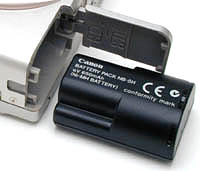 The
S10 utilizes either a 2CR5 lithium battery or an optional nickel-hydride NB-5H
battery pack as well as a CR2016 lithium battery for the internal date and time
backup. The camera ships with a 2CR5 lithium cell in the box, but the (optional)
battery pack and charger should absolutely be considered required equipment,
as the lithium batteries are grossly too expensive to consider for routine use.
(Given their exceptional shelf life though, they make an excellent backup power
source!) Actually, our standard recommendation of at least two rechargeable
batteries (so one can be recharging while the other is in use) holds in the
case of the S10 as well. The power supply kit accessory also serves as the AC
adapter for the camera. Canon estimates that the NB-5H, under normal shooting
conditions, should provide approximately 55 shots with the LCD monitor on, around
230 with it off or about 50 minutes of image playback time. We don't measure
playback time or number of pictures captured directly, but our own impression
was that these numbers seemed slightly optimistic, although not as much so as
some we've seen for other cameras.
The
S10 utilizes either a 2CR5 lithium battery or an optional nickel-hydride NB-5H
battery pack as well as a CR2016 lithium battery for the internal date and time
backup. The camera ships with a 2CR5 lithium cell in the box, but the (optional)
battery pack and charger should absolutely be considered required equipment,
as the lithium batteries are grossly too expensive to consider for routine use.
(Given their exceptional shelf life though, they make an excellent backup power
source!) Actually, our standard recommendation of at least two rechargeable
batteries (so one can be recharging while the other is in use) holds in the
case of the S10 as well. The power supply kit accessory also serves as the AC
adapter for the camera. Canon estimates that the NB-5H, under normal shooting
conditions, should provide approximately 55 shots with the LCD monitor on, around
230 with it off or about 50 minutes of image playback time. We don't measure
playback time or number of pictures captured directly, but our own impression
was that these numbers seemed slightly optimistic, although not as much so as
some we've seen for other cameras.

Here's how the S10's actual power consumption measured up:

|
Operating Mode
|
Power Drain
|
| Capture Mode, w/LCD |
870 mA
|
| Capture Mode, no LCD |
120 mA
|
| Capture, half-pressed shutter w/LCD |
1090 mA
|
| Capture, half-pressed w/o LCD |
770 mA
|
| Memory Write (transient) |
960 mA
|
| Flash Recharge (transient) |
1200 mA
|
| Image Playback |
530 mA
|
| AF assist light |
1400 mA(!)
|
| "Sleep" Mode |
~1 mA
|

These power consumption numbers are a bit high relative to those we've measured
for some competing cameras, but one factor might be that we measured these values
directly at the battery pack (using the AC adapter cord), rather than via an
external power connection (always at a higher voltage than the batteries), as
we do for most cameras. Still, our impression was that the S10's battery life
was a bit on the short side, so we strongly recommend buying and bringing along
a second battery.

Included Software
Learn what the manual left out -
How to *use* your camera.
|
| Camera manuals are (sometimes) fine for knowing
which button does what, but where do you go to learn how and when
to use the various features? Dennis Curtin's "Shortcourses"
books and CDs are the answer. (Cheap for what you get, too.) Order
the Shortcourses manual for the camera reviewed in this article. |
|
When you're ready to download captured images to your computer, the S10 can
accommodate both PC and Mac users with the appropriate serial and USB cables
packaged with the camera. We heartily thank Canon for the inclusion of the USB
cable, which saves iMac users from having to procure a separate adapter. The
included software CD contains PowerShot Browser 1.0, PhotoStitch 3.0, a PowerShot
Plug-in Module 3.0 and Adobe PhotoDeluxe, compatible with Windows 95, 98 or
NT 4.0 and Macintosh OS 7.5.3 or higher. The PowerShot Browser simply downloads
captured images from the camera. PhotoStitch supports any panorama shots taken,
automatically 'stitching' them together. And finally, Adobe PhotoDeluxe gives
you the ability to correct and manipulate images with a variety of filters and
tools. PhotoDeluxe also assists with creating novelties like greeting cards
and calendars, either for printing or use on the Internet.

Test Results
In keeping with our standard policy, our comments here are rather condensed, summarizing
our key findings: For a full commentary on each of the test images, see the
S10's "pictures" page.

As with all Imaging Resource camera tests, we encourage you to let your own eyes
be the judge of how well the devices performed: Explore the images on the pictures
page, to see how well the S10 performed, and how its images compare to other cameras
you may be considering buying.

Overall, we were extremely impressed with the quality of the images produced by
the S10. In truth, we rather expected to find that the lens had limitations or
excessive distortion, given the tiny body it's crammed into: Surely there would
be compromises made in this respect. (We really had no basis for this belief,
as we haven't seen any evidence of such compromises in other tiny cameras we've
tested, whether from Canon or others. Still, the thought was there.) We were amazed
then, to find that the S10 produced photos that are easily in the top tier of
current 2 megapixel camera offerings. (November, 1999) Resolution and detail were
tack-sharp, and color was excellent as well.

In the resolution test, the S10 tested out at a solid 700 lines per picture height
in both horizontal and vertical directions. Even at very high spatial frequencies,
there's virtually no aliasing. The lens shows relatively little geometric distortion
throughout its zoom range, running from 0.5% barrel distortion at the wide angle
end to 0.3% barrel distortion in telephoto. Chromatic aberration was slight, estimated
at ~0.5 pixel (0.03%.

Perhaps our biggest complaint about the camera is that its optical viewfinder
is quite "loose", showing only 77% of the final image area across the
full range of the zoom lens. This is less accurate than most cameras we've tested,
but the LCD viewfinder compensates somewhat, by being a bit more accurate than
most, ranging from about 102% of final view at wide angle(?!) to 95% at telephoto.

In Macro mode, the S10 acquits itself well, providing a minimum capture area only
2.0 x 2.7 inches (51 x 68 mm), at a working distance of about 4.7 inches (12 cm).
This doesn't reach the microscopic levels of some recent cameras, but is well
in the mainstream of the present market.

Image quality was exceptional overall: Sharpness and resolution are clearly in
the top tier of the current (November, 1999) 2 megapixel market, and color is
really excellent as well. The only (minor) weakness we could find anywhere was
somewhat lower color saturation in blues and greens. Image noise is very low with
default ISO setting (ISO 100), and increases relatively gradually as the ISO is
boosted to 200 and 400. Low light performance was modest though, as the boosted
ISO ratings appear to only provide shorter shutter times, not lower working light
levels. Still, the approximately 1 foot-candle (11 lux) minimum usable light level
is perfectly adequate for capturing images in dim interior settings, or outdoors
at night under typical street lighting.

While it probably doesn't need to be said again, we were very impressed with S10's
picture quality, particularly given its diminutive size.

Conclusion
The exceptional take-anywhere compactness and rugged construction of the PowerShot
S10 make it an imposing competitor on the digicam playing field. The four capture
modes give you a nice range of options and versatility and you have reasonable
exposure control as well. Combine that with resolution and image quality at the
top of the market for two megapixel digicams (as of November 1999), and you have
an excellent digicam that we anticipate will do very well with consumers. Other
than adding a longer-ratio zoom lens or a more accurate optical viewfinder, it's
hard to find any way in which the S10 could be improved!

<<PowerShot S10 Sample Images
| Additional Resources and Other Links>>
Reader Comments!
Questions, comments or controversy on this product? Click
this link to see what other Imaging Resource readers have had to say about
the Canon PowerShot S10, or add comments of your own!
Back
to Full Canon PowerShot S10 Review
The
S10 utilizes either a 2CR5 lithium battery or an optional nickel-hydride NB-5H
battery pack as well as a CR2016 lithium battery for the internal date and time
backup. The camera ships with a 2CR5 lithium cell in the box, but the (optional)
battery pack and charger should absolutely be considered required equipment,
as the lithium batteries are grossly too expensive to consider for routine use.
(Given their exceptional shelf life though, they make an excellent backup power
source!) Actually, our standard recommendation of at least two rechargeable
batteries (so one can be recharging while the other is in use) holds in the
case of the S10 as well. The power supply kit accessory also serves as the AC
adapter for the camera. Canon estimates that the NB-5H, under normal shooting
conditions, should provide approximately 55 shots with the LCD monitor on, around
230 with it off or about 50 minutes of image playback time. We don't measure
playback time or number of pictures captured directly, but our own impression
was that these numbers seemed slightly optimistic, although not as much so as
some we've seen for other cameras.